The history of the Toyota Hilux spans eight generations, during which the pick-up has earned a reputation as one of the world’s most trusted and reliable commercial vehicles. Having survived extreme environments in the Arctic and Antarctic – and all points in between – the credentials of this ultra-tough machine are proven beyond doubt.
It has sold more than 19 million units, while it remains Europe’s most popular pick-up with sales just shy of 36,000 units in 2018.
Yet despite its no-nonsense approach, the Hilux package has gradually developed over the years to become a complete motoring solution, bridging the gap between work use and everyday driving needs.
History of the Toyota Hilux: Partnership agreement
Technically, the history of the Toyota Hilux begins outside of Toyota Motor Corporation. Its roots are found in the Briska line of small pick-ups made by Japanese commercial vehicle manufacturer Hino Motors since 1961. Toyota’s history with pick-ups dates back to the SB model of 1947 but halfway through production of the second-generation Briska, Toyota partnered with Hino Motors and pushed forward minor model improvements.
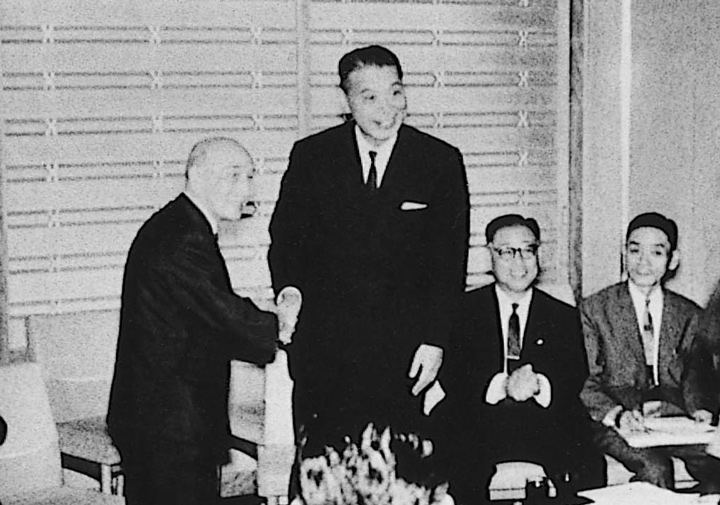
The Hino Briska was renamed the Toyota Briska from 1967, signalling a refocusing of the Hino brand towards production of medium- to heavy-duty commercial vehicles instead.
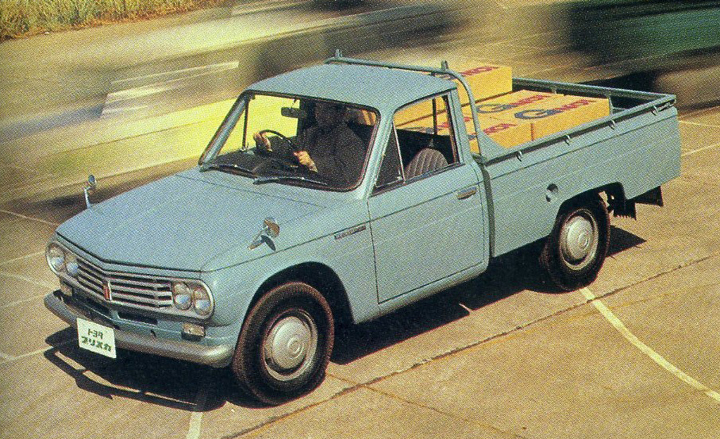
History of the Toyota Hilux: Arrival of the fittest
It was March 1968 when Toyota dealerships in Japan took delivery of the first genuine Toyota Hilux pick-up. This new model bore the N10 chassis code, and although it was conceived by Toyota, the new Hilux continued to be engineered and built at Hino Motors’ Hamura Plant.
Upon its launch, the Hilux swelled Toyota’s light-duty pick-up range from two to three separate models, the new pick-up joining the existing Corona and Masterline (Crown). The latter two were car-based derivatives and Toyota swiftly phased them out to create space between Toyota’s light commercial vehicle range and its passenger cars.
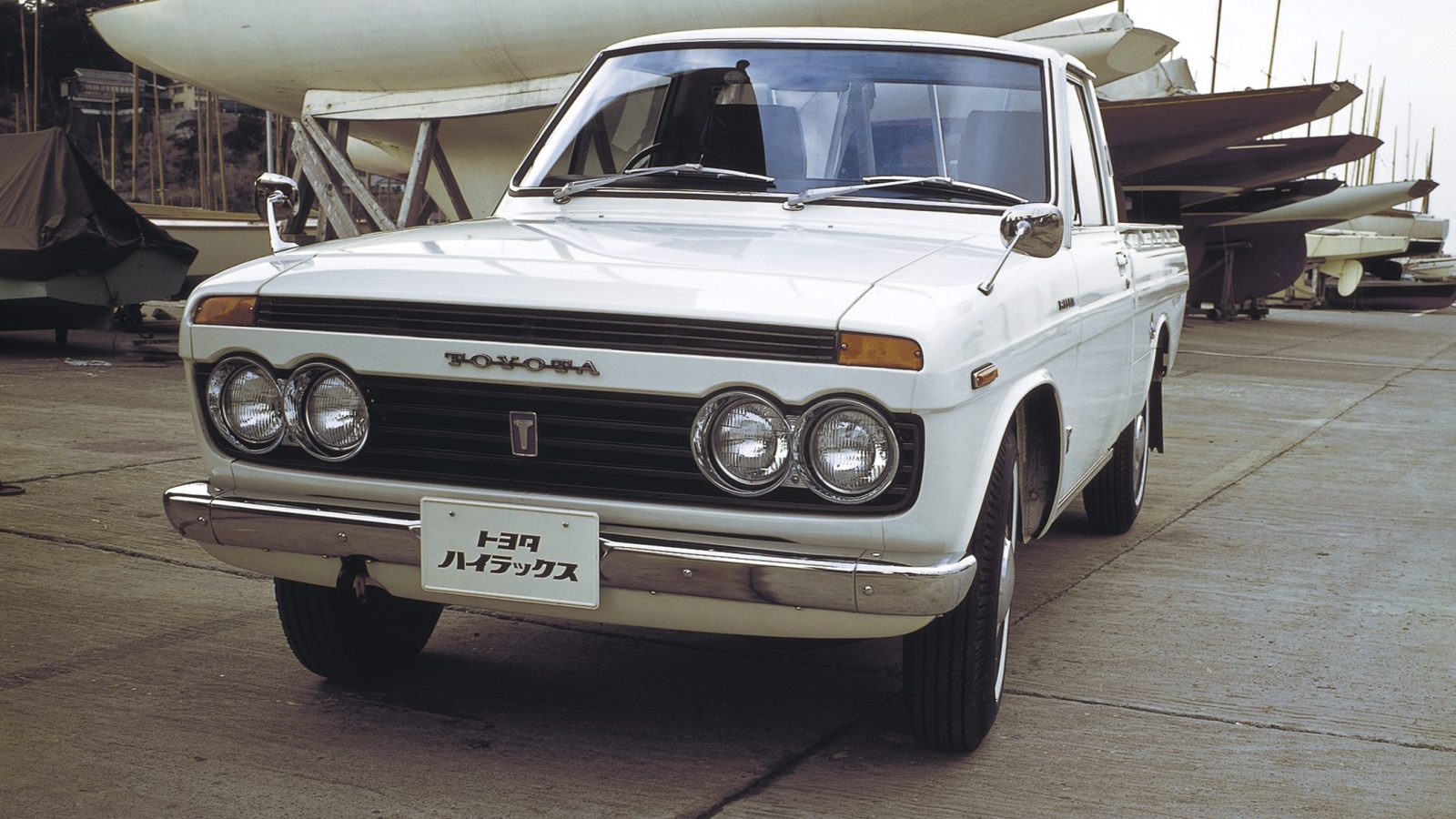
The new Hilux – its name a contraction of ‘high’ and ‘luxury’ – utilised a separate frame construction with a double wishbone/coil spring suspension set up at the front and rigid axle/leaf spring arrangement at the rear.
At the outset, the Toyota Hilux began as a short-wheelbase model powered by a four-cylinder 1.5-litre R-series petrol engine with a column-shift, four-speed manual gearbox driving the rear wheels. Just over a year into production in April 1969, the Hilux range grew (literally) to include a long-wheelbase model. February 1971 witnessed the arrival of a gutsier 1.6-litre version that replaced the base engine. Passenger capacity was for three people sat abreast on a bench seat.
For the important North American market, Toyota made some unique changes. To begin with, the Hilux name wasn’t used – instead, the pick-up was simply badged as the ‘Toyota Truck’ to prevent confusion over its name and purpose. The American market received larger 1.9- or 2.0-litre R-series powerplants, and only the short-wheelbase chassis with its 1.85m long bed was offered to buyers.
History of the Toyota Hilux: More comfortable stretch
The second-generation Hilux was launched in May 1972 for the 1973 model year, and marked the model’s introduction to the UK market. Essentially a reworked version of its predecessor, the N20 series featured an updated body with slightly extended wheelbases, more comfortable interior and carry-over engine range.
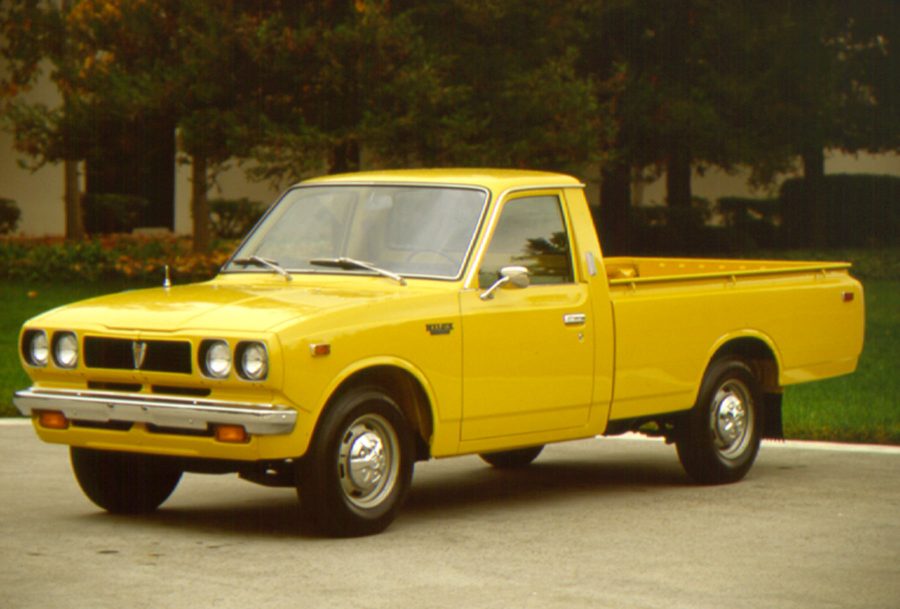
Also improved for the second-generation were Hilux’s safety features – it now had servo-assisted dual brake master cylinders and load-sensing brake proportioning valves. And soon after launch, the North American market saw the introduction of a long-wheelbase model with a 2.25m loading bed (see comparison below between N10 and N20 series load bays). A column-mounted four-speed manual gearbox was the standard transmission setup, though buyers were now able to specify a floor-mounted gearshift, deleting the three-person bench in favour of two individual seats.
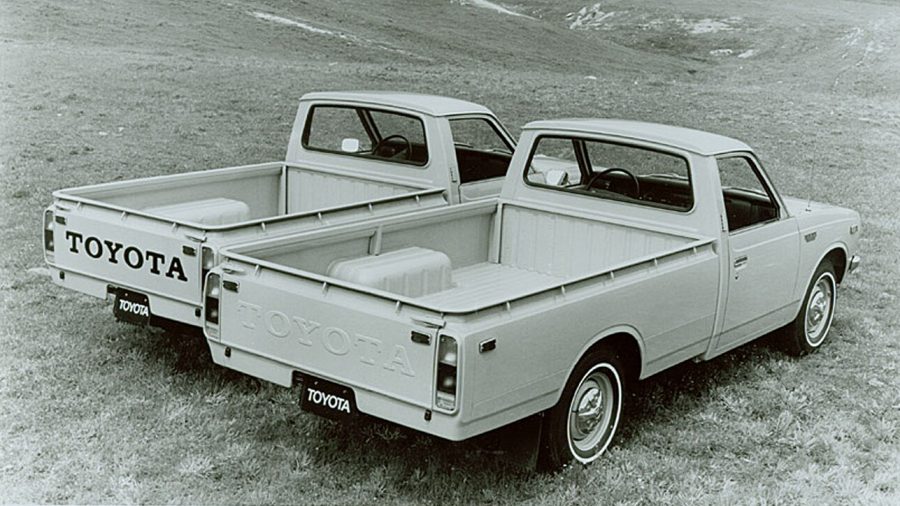
A higher specification model was introduced to some markets from 1974 onwards, offering a more powerful 2.0-litre R-series engine and optional three-speed automatic gearbox, the first of its kind ever fitted to the Hilux.
This move upmarket was mirrored in the US in 1975 with the introduction of a larger 2.2-litre motor and SR5 trim designation, along with the option of a five-speed manual gearbox. In October 1975 the 2.0-litre engine was deleted in all other markets, consolidating the Hilux to one 1.6-litre unit to meet new emissions standards.
History of the Toyota Hilux: Versatile equipment
Versatility was the watchword for the third-generation N30/40 series Hilux when it went on sale in September 1978. Regardless of model – there were now three standard-length and four long-wheelbase derivatives – the third-gen Hilux was designed to offer saloon-like specification and ride comfort. This led to an evolution of the predecessor’s double wishbone front suspension that replaced the coil springs for a torsion bar.
Significantly, a new top-of-the-range Super Deluxe model was introduced from launch; its extended cab was 90mm longer than standard, significantly improving interior space. The Super Deluxe was later supplemented with a full double-cab version with four doors and two rows of seats. All higher-grade models received front disc brakes as standard, and buyers could now specify a Toyota-embossed tailgate. Many of these improvements were borne out of Toyota’s careful study of the US market, where the Truck routinely doubled as a passenger car and leisure vehicle. Even the cover of the Japanese brochure for the Hilux proclaimed that it was “born in Japan, raised in the US”.
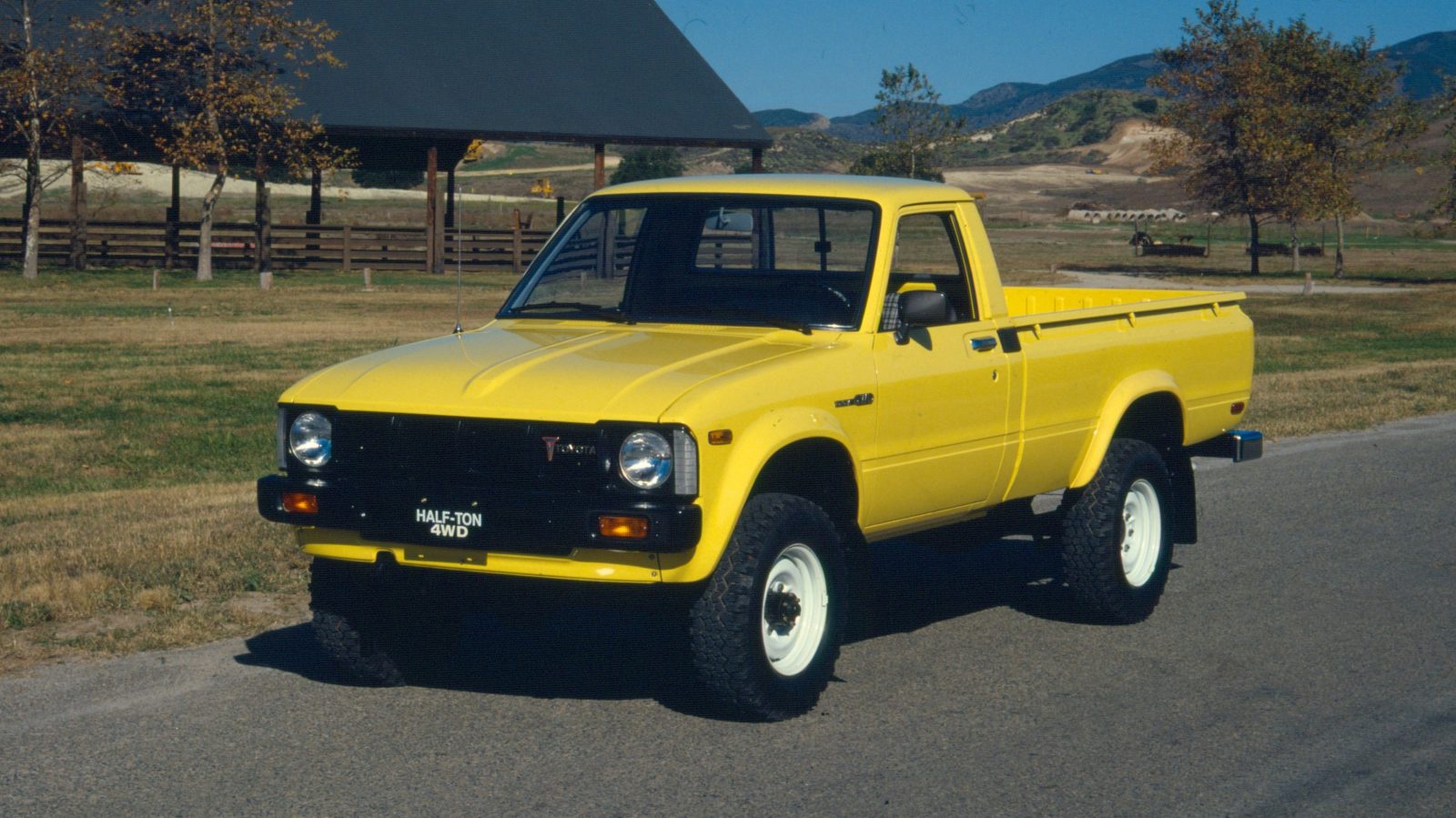
The new dual-purpose nature of Hilux was reinforced by the first four-wheel drive model in October 1979, which adopted the driveline and gearbox transfer case from the 40-series Land Cruiser allied to a reworked version of the now-reinstated 2.0-litre R-series petrol engine. Diesel power followed with a 2.2-litre L-series engine, available for the first time in both rear- and four-wheel drive formats.

Toyota further emphasised Hilux’s lifestyle usage in 1981 when the maker partnered with Winnebago Industries and two other vehicle body manufacturers in the US market to produce SUV-type recreational vehicles. Based on the four-wheel drive Truck chassis cab, these companies added different fibreglass bodies to the steel framework around the rear wheels.
In fact, the success of these early walkthrough conversions led directly to Toyota’s launch of the Hilux-based 4Runner and Hilux Surf station wagon models which appeared early in the fourth-generation’s life cycle.
History of the Toyota Hilux: Hilux meets SUV
Toyota released the fourth-generation Hilux in November 1983, and for a while it was available alongside its predecessor, which remained on sale in the domestic market as a rear-wheel drive base model.

However, the newer generation vehicle was immediately characterised from its older sibling by attractively blistered arches and a renewed interior. What didn’t change was its reputation for near-indestructibility; a fact that was underlined by BBC Top Gear in its unsuccessful attempts to ‘kill’ one hard-worked example.

Single- and double-cab versions were available from launch, including a new raised-bed model with three bottom-hinged sides. These additions increased the number of Hilux variations from 17 to 20.
Buyers of rear-wheel drive models could choose from four engines – 1.6- or 1.8-litre petrol, and 2.2- or 2.4-litre diesel – while four-wheel drive models used either a 2.0-litre petrol or the largest 2.4-litre diesel.
Since the launch of the fourth-generation Hilux, the worldwide market for recreational vehicles had grown exponentially, with SUVs like the Ford Bronco and Nissan Pathfinder suddenly appearing on forecourts.
Toyota reacted swiftly and with simplicity by modifying the short-frame bed of the Hilux, removing the bulkhead from the back of the cab, adding a one-piece fibreglass-reinforced plastic canopy, fitting a bench seat in the back, and softening the rear suspension. Larger engines were fitted, including 2.4-litre turbo and 3.0-litre V6 petrol engines, though the larger dimensions of these units required the development of a wider front track and the switch from a solid front axle to an independent set up.
The vehicle that resulted from this unforeseen refresh was launched to the world from May 1984 onwards as either the Hilux Surf (domestic market) or 4Runner – essentially a three-door station wagon with off-road capability similar to that of the Land Cruiser. Toyota also adopted modifications from the A-pillar forwards throughout the entire Hilux range.
History of the Toyota Hilux: Refining the concept
September 1988 marked the introduction of the new fifth-generation Hilux, with revised bodywork that represented many visual and physical improvements over the outgoing version.
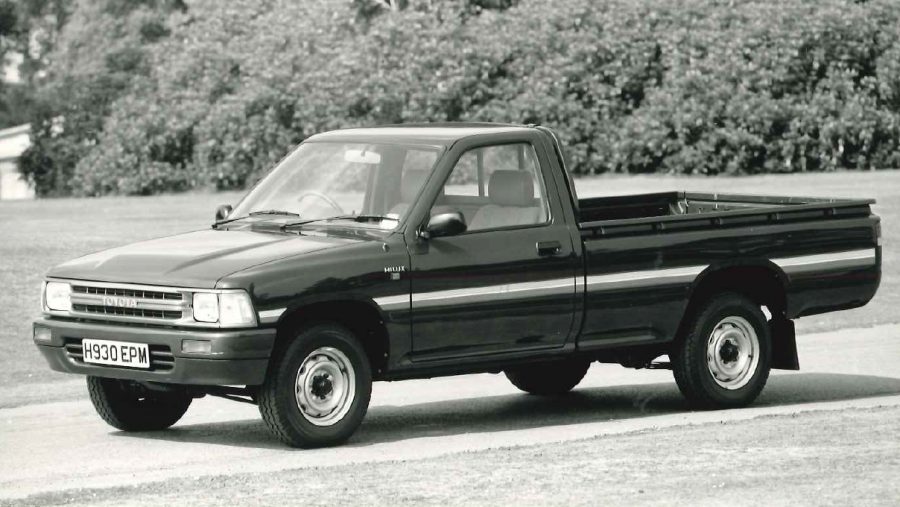
Built to the three core concepts of power, sturdiness and comfort, the new model’s interior was far more car-like in terms of equipment level and dashboard design. Outside, the exterior bodywork now featured integrated window sashes in the doors and a one-piece loading bay that eliminated the worry about rust developing in the seams.
Four-wheel drive models received distinctive arch flares that widened the overall body by 40mm, while rear-wheel drive models had a narrower style with traditional flat-sided front wings and rear quarter panels.

The engine range similarly differentiated between four- and rear-wheel drive models; the latter either received a new 1.8-litre Y-series petrol or 2.4-litre L-series diesel, the former a gutsier 2.0-litre Y-series or 2.8-litre diesel. Later in the N50’s production the engine range of the rear-wheel drive models was upgraded to match that of the four-wheel drive versions.
Meanwhile, the 3.0-litre V6 petrol engine was reserved for double-cab models and the second-generation Surf/4Runner. In answer to diversifying customer needs, the number of rear-wheel drive models available with the four-speed automatic gearbox was increased.
The second-generation Hilux Surf/4Runner arrived for the 1990 model year, again built on the Hilux platform; indeed, the models were almost identical from the B-pillar forward. However, whereas the first-generation model had a simple FRP structure on top of the pick-up bed, the new car featured a fully integrated steel body with five doors (a three-door was available during the first half of the production cycle but is very rare) and all-new coil sprung rear suspension.

This model was discontinued in 1995, and from its third-generation onwards the Hilux Surf/4Runner switched to use the Land Cruiser Prado platform.
Further changes were in store for the fifth-generation Hilux across worldwide markets. Toyota forged a partnership with Volkswagen in 1989 to further its presence in Europe, after which the German manufacturer launched the Taro, a barely-disguised badge-engineered version of the Hilux. The decision was also made that when the N50 ceased production, the US market would switch from the Hilux/Truck range to the larger, more genuinely truck-like Tacoma pick-up.
History of the Toyota Hilux: Sixth sense
With the multipurpose Hilux Surf/4Runner line now forging ahead independently, Toyota gently refocused the new sixth-generation Hilux pick-up range into two clear branches – business use and personal use.

The range was introduced in Japan in September 1997 and is easily distinguished from previous generation models by a swage line that gently tapers downwards toward the front indicators. Once again it was available with two- or four-wheel drive transmission and either single- or double-cab body configurations. The engine line-up consisted of 2.0- and 2.7-litre four-cylinder petrol units as well as 2.4-litre turbo and 3.0-litre naturally aspirated diesels.
Personal-use models were now borderline sporty, equipped with additional equipment and devices to better suit their recreational intentions, such as a longer and taller cabin with improved sound insulation. Business-use models, on the other hand, were more basic and offered lower specification levels.
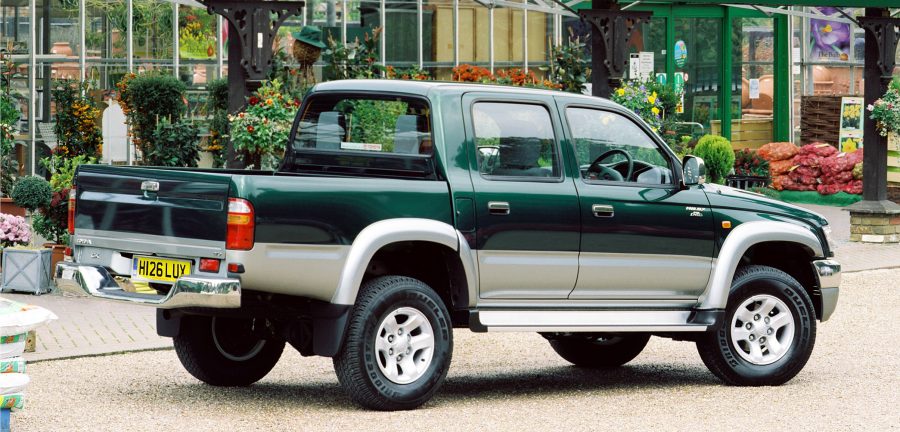
The biggest change for the sixth-generation was that all Hilux models now came with independent front suspension – the first time in the history of the Toyota Hilux. A solid axle may have been the traditional setup for off-road use but contemporary Land Cruiser models had proved the effectiveness of independence without sacrificing too much suspension travel, while delivering huge improvements in ride quality and handling.
Arguably this development helped the sixth-generation Hilux recapture its lead in the commercial one-ton pick-up market. This status was immortalised in July 2004 when the UK range expanded to include a new high-spec Invincible model, though that may have had something to do with the recent airing of the Top Gear programme mentioned earlier.
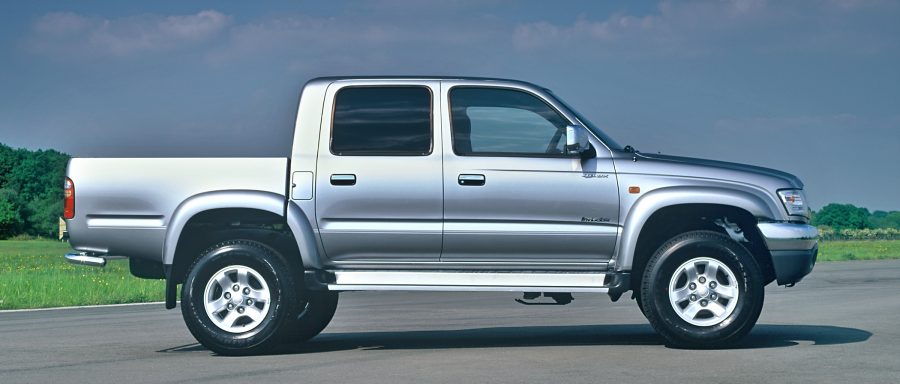
History of the Toyota Hilux: Seventh heaven
Based on a modified version of the previous generation’s ladder frame underpinnings, the seventh-generation Hilux grew significantly in stature to become classified as a mid-size pick-up (the platform was also adapted into an SUV for the Toyota Fortuner model). This change gifted the car with greater road presence, interior space, and load capacity – all improvements identified from customer reports.
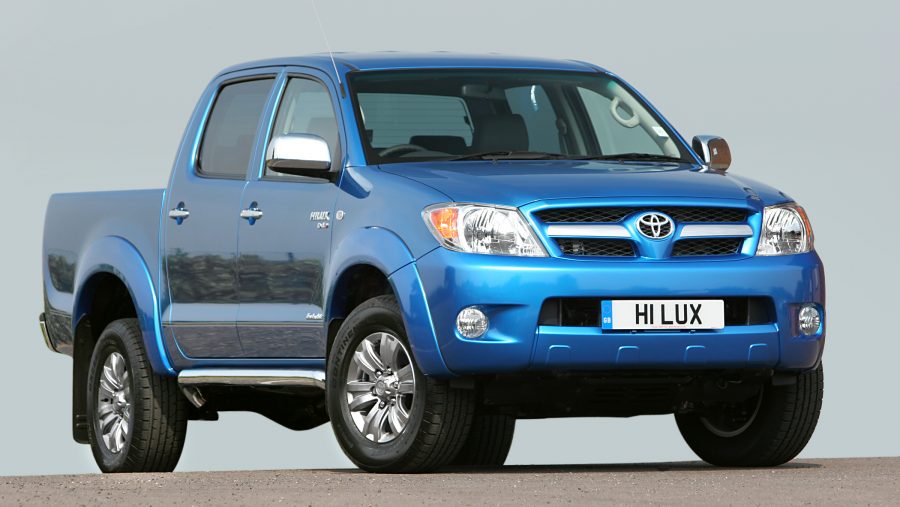
Perhaps more than any other Hilux generation before it, this seventh iteration saw numerous, successive improvements throughout its life, enabling the model to consistently exceed consumer needs and ever-tightening emissions standards.
For instance, soon after its October 2005 launch in the UK, a third body style was inserted between the single-cab two-door and double-cab four-door variants. Called the Extra Cab, it offered seating for four behind just two doors and a longer load bay than that of the traditional double-cab.
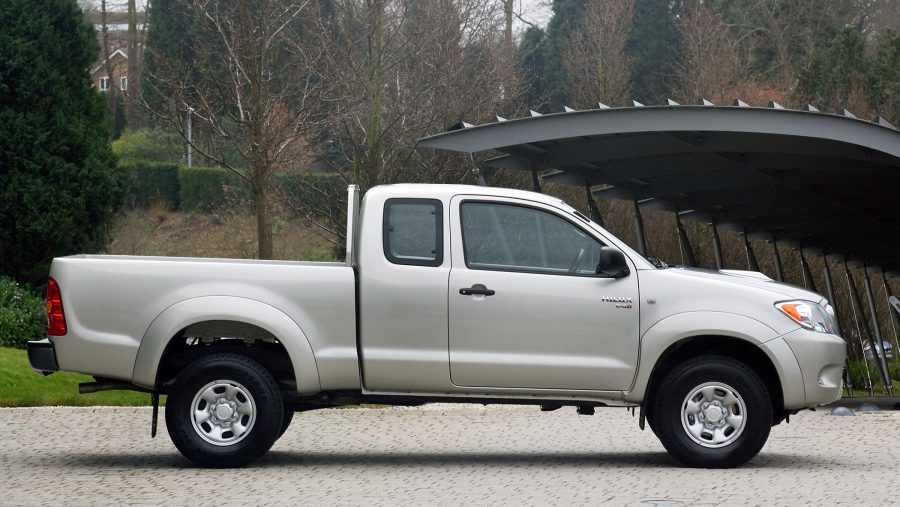
A new twin-cam 3.0-litre 16-valve D-4D diesel engine became available in January 2007 to supplement the existing 2.5-litre D-4D, thereby elevating the entire range to Euro 4 emissions standards.
Soon afterward, this modern unit was put to the ultimate test of reliability by successfully powering Top Gear’s latest assault on the Hilux’s reputation to the North Magnetic Pole – a first for any motor vehicle. Further challenges saw the Hilux provide transport for an expedition to the South Pole and climb an erupting volcano in Iceland to retrieve lava samples, both of which it survived. Little wonder the Invincible grade remained available in this generation too.

A comprehensive re-style was applied in October 2011 for the 2012 model year, encompassing smoother architecture from the A-pillar forwards. Inside, the upper dashboard was new and housed the latest versions of the Toyota Touch multimedia system for all mid- and high-grade models. Finally, the two diesel engines now met Euro 5 emissions regulations while being more powerful and economical than ever before.
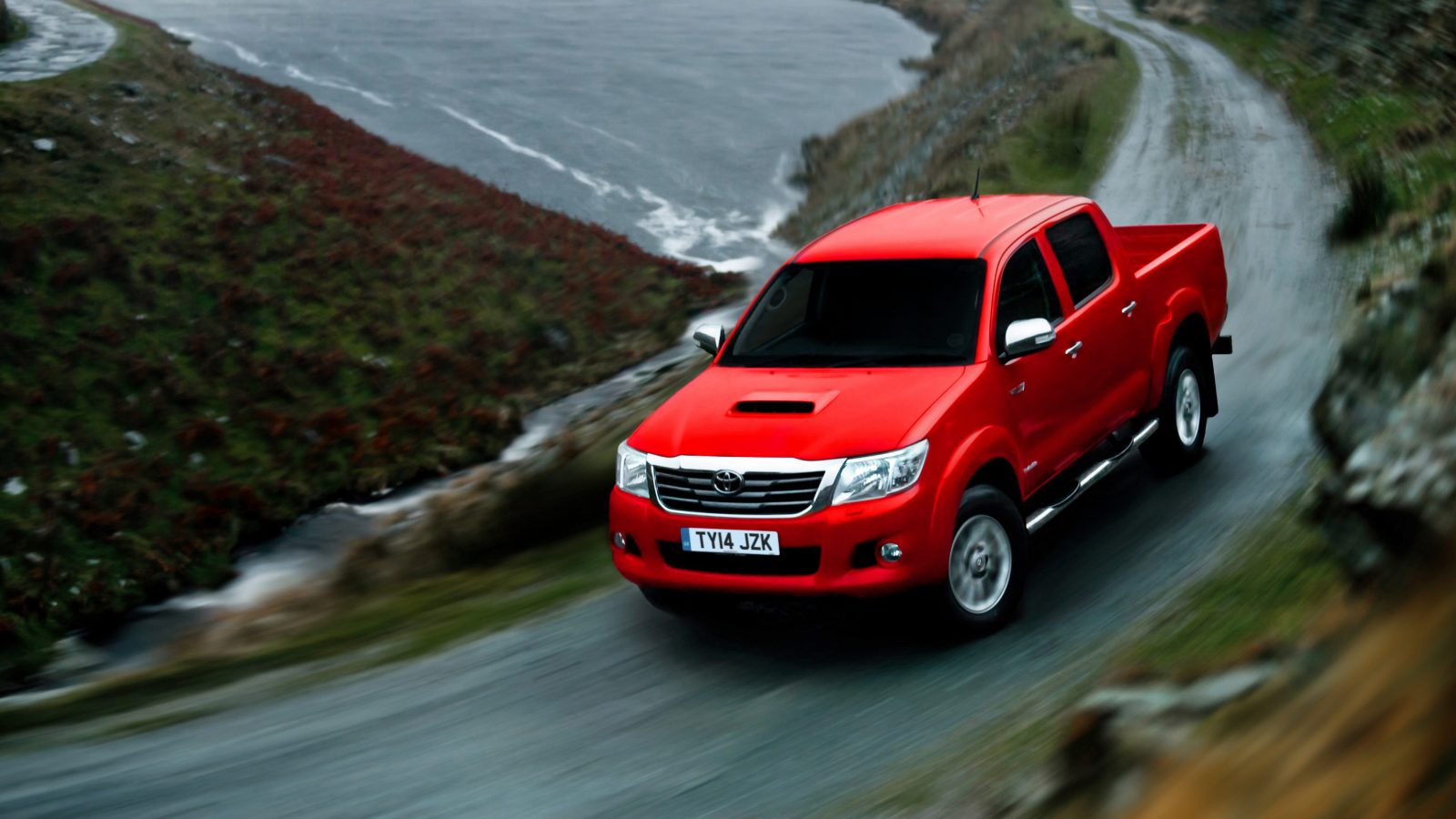
History of the Toyota Hilux: Eighth wonder
By 2015, Hilux had accumulated 16 million sales worldwide, and even in the last year of production it maintained class dominance in Europe by securing almost one-quarter of all pick-up sales. Toyota clearly had no intention of Hilux losing its reputation as the complete and super-tough motoring solution for its eighth generation.
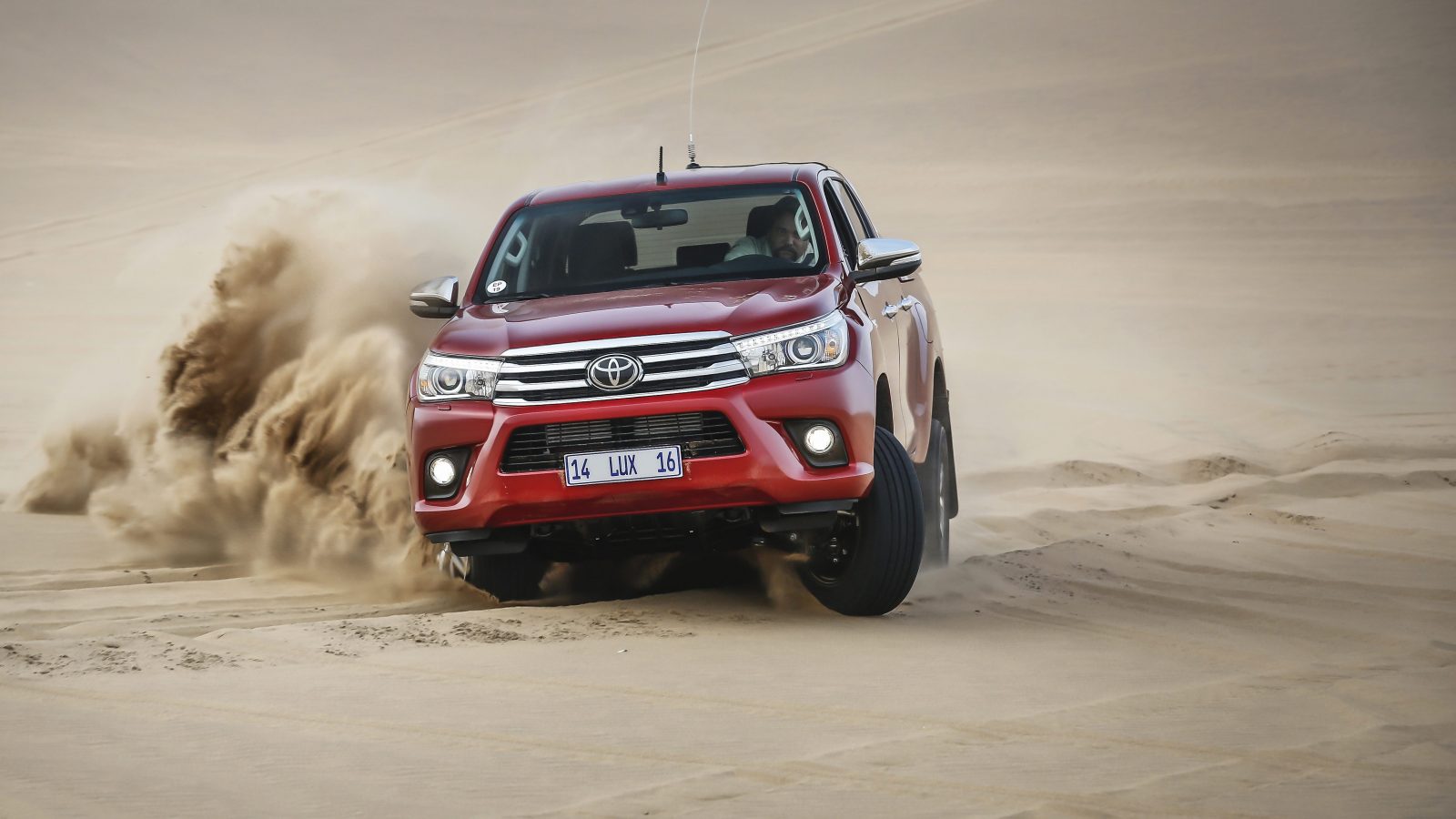
Available once again in Single Cab, Extra Cab and Double Cab body styles, the new generation Hilux advances the legend and redefines toughness with a stronger ladder chassis, reinforced deck structure, enhanced all-wheel drive capabilities and improved towing capacity.
At the same time, it responds to the growth in use of pick-ups for leisure in recent
years, offering a contemporary design, higher comfort levels, advanced equipment
features and improved safety, making it more stylish and stress-free to drive than
ever before.
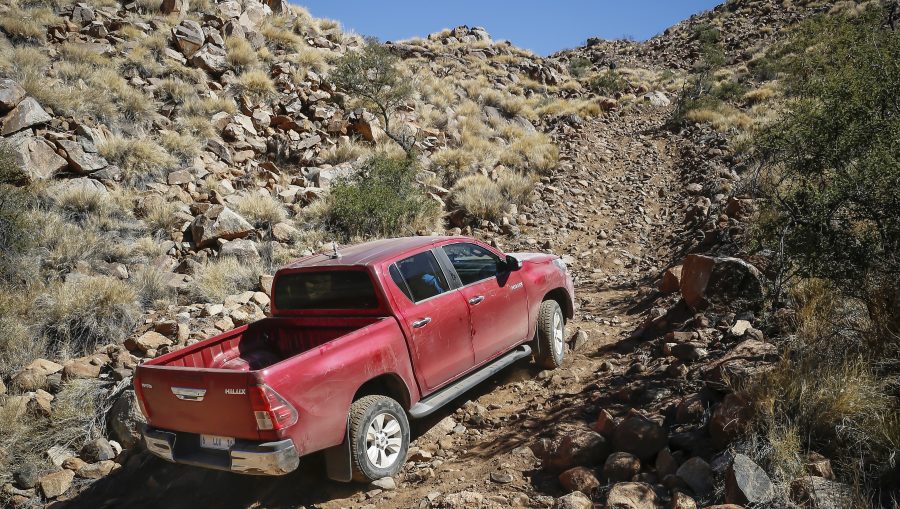
The first UK customer deliveries of the new eighth-generation Hilux began on 1 July 2016 and a process of continuous improvement has kept it ahead of the game. The latest Hilux has a larger, stronger and more practical cargo deck and an improved towing capacity of up to 3.5 tonnes.
The 2.4-litre D-4D engine delivers improved fuel economy, with combined cycle consumption from 29.12 to 32.47mpg for the Active Single Cab and 28.82 to 29.73mpg for the Invincible X Double Cab with automatic transmission (WLTP combined cycle data). From autumn 2019, the engine gained an eco stopstart system for Icon grade models and above.
Hilux is sold in the UK with the benefit of a five-year/100,000-mile warranty, bringing it into line with the generous cover Toyota provides for its new passenger vehicles.

In early June 2020, an overhauled version of the eighth-generation Hilux (pictured above) was unveiled. It features a striking new design, a powerful 2.8-litre powertrain, and equipment upgrades that will increase its appeal for business and leisure users. Read all about it by clicking here.
Make your own contribution to Hilux history by visiting your local Toyota centre and organising a test-drive by clicking here.

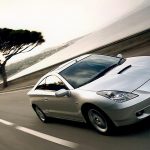
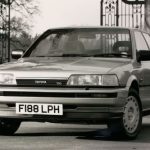










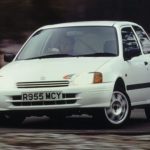
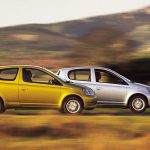




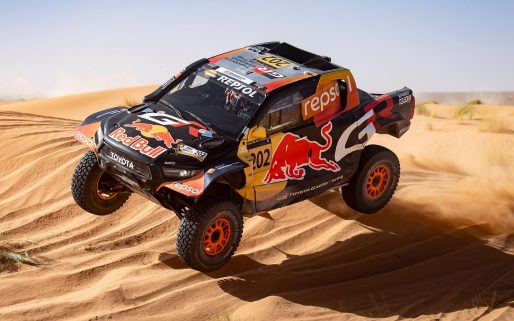
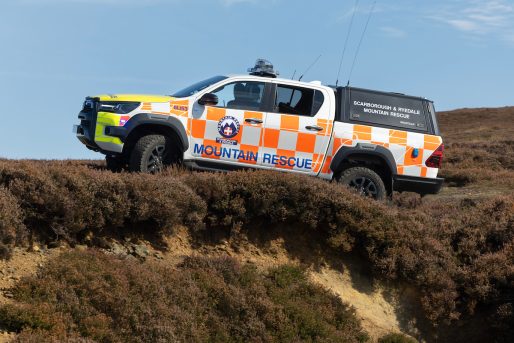
I luv `em
Vile-looking, a defender is far better
Having been unfortunate enough to own a few defenders I can assure you that the Toyota is superior mechanically / build quality and reliability –
In Australia the saying goes –
You go into the bush in a landrover – you return in a Toyota
Good luck with your Defender – you will need it
Proud owner of an ugly brown 1987 std. model short bed Toyota. Was researching stake bed construction when I came across this article. Great write up, very elaborate and succinct. These little trucks are damn near indestructible except for the rust. I paid $100 for mine. It only had 120K when I got it last year, and though it’s ugly outside, the frame is solid and mechanically it’s top notch. I’ve done a lot of work, replacing rotten brake lines and such, and look forward to having it for a long time. Brings back nostalgic memories of my uncle’s blue ’86. It was his first brand-new vehicle and served him well for many years and nearly 400K of service.
Hi Yoyo
Thanks for post and good to hear about your Hilux. Glad you like the article.
Great to hear your story about Hilux ownership and that your 87 model is still going strong.
Best wishes
toyota is bettercar of the world
i like its very much
Hilux hl3 2.4 2012 mpg and
3.0mpg can anyone help me please
Hi Rukhsar
Thanks for your post.
If you are concerned with the fuel consumption of your Toyota Hilux then we recommend that you get in touch with your nearest Toyota dealer who will be able to advise regarding a fuel consumption test for you.
Hope this helps.
Hi
Can any expert help me with an issue: the LHD Hilux Gen7 is rated as maximum mass 2690 kg (or so) whereas the RHD is rated 3010kg. Any idea why this discrepancy exists and what can be done about a LHD model to modify to achieve the same 3t spec (1t load capacity) as the RHD?
Tx
Robin
Hi there,
Thanks for your post. After speaking with our technical team, we would not expect a massive difference in terms of Kurb or Gross Vehicle Weight between a LHD and a RHD vehicle, provided we are comparing the same body type vehicles, i.e both vehicles are single cab, extra cab or double cab. Would you be able to provide us with the exact details of the vehicle as well as the details of the comparison vehicle in order to make sure that we are making a fair comparison? Many thanks.
Hi, tx. Perhaps the easiest thing to do is to reproduce the specs. in the manual:
5486-1. SpecificationsHILUX_EE (OM0K099E)Extra-cab modelsGross vehicle mass4WD modelsLeft-hand drive vehicles2620 kg (5776 lb.)Right-hand drive vehicles3010 kg (6636 lb.)Pre Runner2590 kg (5710 lb.)Maximum permissible axle capacityFront1280 kg (2822 lb.) RearLeft-hand drive vehicles1600 kg (3527 lb.)Right-hand drive vehicles1900 kg (4189 lb.)Drawbar load100 kg (220 lb.)Towing capacityWithout brake750 kg (1654 lb.)With brake2500 kg (5512 lb.)
Vehicle is a 2011 2.5 D4D Hilux, manual. I can provide the VIN if you have an email address?
As you can see above, there is a 300kg delta on the rear axle limit between the LHD and RHD vehicle, but no obvious reason why!
Tx again,
Robin
Hi Robin,
I’ve spoken further with our technical team. They had a look in the Owner’s manual and were able to confirm that you are right.
They also had a look in TMC’s Homologation website and were able to confirm that the information mentioned in the Owner’s manual (related to the Gross Vehicle Weight) is correct. However, TMC’s Homologation website showed a very small difference in Kerb Weight bewteen LHD and RHD vehicles. Therefore, the actual difference lies within the payload the vehicle can carry. Unfortunately, our technical team are unable to explain why this is. If you would like us to look into this further with another team we can? Please let us know if this answers your question. Many thanks!
Yes, that’s very interesting – and to resolve the issue (ideally up-plating the vehicle), I would need and appreciate the support of Toyota GB!
Can we continue off-line via email?
Thanks again
Robin
Hi Robin,
We’re still looking at this and we will keep you updated when we hear something! I’ve taken note of your email address and we will contact you. Many thanks!
Great, thank you!
I look forward to hearing further. It’s a strange one…
Robin
Whatever we said or wrote about TOYOTA we won’t give what it is deserved
Simply it is priceless treasure …
Hi Abu,
Thank you for your kind words.
Hi, is there any difference in 2016+ hiluxes with regards to the chassis strength etc? I’m looking to build an overland vehicle and wonder if there are certain chassis models that are build stronger then other version. Many thanks!
Hi Roy,
Thanks for getting in touch. We can confirm that the 2016 Hilux is different to the current model. Both are very strong and there is a body builders guide on Tech Doc that you can download: https://www.toyota-tech.eu/BBG.aspx.
The 2016 and before was KUN and later than 2016 and on was GUN.
Hope this helps.
Thanks a lot for the response and the link. Studying the documents as we speak. With regards to the 2016+ versions, is there a difference in chassis strength / steering strength / engine mounting etc between Toyota’s build in Thailand vs the ones from Spain and also between different versions (Revo/Rocco vs GX/VX/VXL/Limited etc)?
I will be putting ARB suspension and bumpers etc on it so I’m not worried about those bits, just the strength of the chassis etc. I want to prevent pimping a simple GX version to later find out the chassis is significantly weaker than that of a different model, i.e. the Revo or a VXL etc. Thanks 🙂